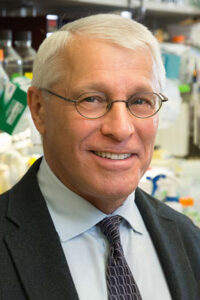New approaches exploit cell plasticity to reduce resistance to cancer therapies

Many epithelial adenocarcinoma tumors tend to respond to initial treatments with chemotherapeutic agents, targeted agents, and combination approaches. But a minority of tumors develop resistance.
“Tumors have multiple mechanisms to escape our therapies to progress and, unfortunately, kill many patients,” said Owen N. Witte, MD, Broad Stem Cell Research Center. “Among other mechanisms, tumors can converge on a stem cell-like phenotype during therapy or during progression to a more aggressive state.”
Witte moderated the Major Symposium Tumor Cell Plasticity and Resistance to Cancer Therapies. Both the symposium and its related panel discussion are available on replay for registrants through June 21. 2021.
Witte explored the clinical progression of prostate cancer, which usually presents as adenocarcinoma with less than 1 percent neuroendocrine prostate cancer (NEPC). Successive rounds of treatment can transform adenocarcinoma to small-cell prostate cancer or mixed tumor types with small-cell feature.
Therapeutic intervention, and occasionally natural mutation, can initiate neuroendocrine transdifferentiation to produce neuroendocrine-like tumor cells or small-cell carcinoma cells, Witte said. Transdifferentiated neuroendocrine-like tumor cells can also progress to cancer stem-like cells that can give rise to small-cell carcinoma cells.
Small-cell cancers from lung and prostate have highly similar transcriptomes, he continued. Small-cell neuroendocrine cancers and hematologic cancers share drug sensitivity profiles and have common functional dependencies.
Researchers have identified at least 18 genes in small-cell prostate cancer that are drug targets, with FDA-approved cancer drugs, Witte said. Approved agents include doxorubicin, etoposide, acalabrutinib, bosutinib, bortezomib, carfilzomib, venetoclax, and lenalidomide.

“We believe that neuroendocrine prostate cancer is treatment induced because we rarely see it in untreated patients,” said Mark A. Rubin, PhD, University of Bern and the Bern Center for Precision Medicine.
SWI/SNF protein complexes play key roles in the transition from adenocarcinoma to small-cell cancer by orchestrating the transition to a stem-like state and pluripotency. Epigenetic modulation of those complexes offers a treatment opportunity window.
“We think it is the stem-like state that offers the greatest potential for targeting this transition to neuroendocrine prostate cancer and attacking it,” Rubin said. “The tumor microenvironment is likely to be important.”
Drug-resistant cells are key to the emergence of treatment-resistant tumors. These drug-tolerant persister (DTP) cells survive treatment and begin to regrow after treatment stops. Targeting tumor cells in their tolerant state might prevent them from emerging and expanding into treatment-resistant tumors.
Osimertinib, an EGFR inhibitor, kills most non-small cell lung cancer cells, but not all. Rather than killing DTPs, treatment simply suppresses apoptosis, allowing them to survive and begin to regrow 4-8 days after treatment ends.

“Cell death is regulated by the intrinsic apoptotic pathway, so why not harness it to kill DTPs?” asked Paul Smith, BSc, PhD, Cancer Research UK, AstraZeneca.
DTPs have several upregulated genes, most notably the family of inhibitor of apoptosis (IAP) with the CARD domain in some cell lines, Smith said. IAP antagonists can inhibit DTPs, but does not eliminate all DTP cell lines.
Ferroptosis, a programmed lethal accumulation of lipid peroxidation, can also inhibit and kill DTPs. GPX4, a lipid hydroperoxidase, protects against membrane lipid peroxidation and cell death. RSL3 inhibits GPX4 to increase ferroptosis.
“The DTP state is drug dependent and reversible,” Smith said. “We now know we can induce apoptosis in DTPs to enhance osimertinib and that DTPs are vulnerable to ferroptosis. We don’t yet understand the differences.”
